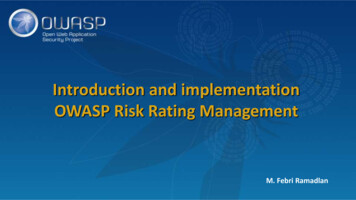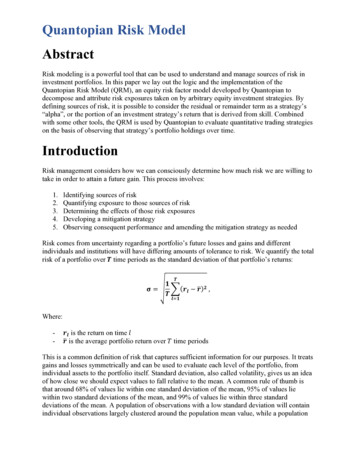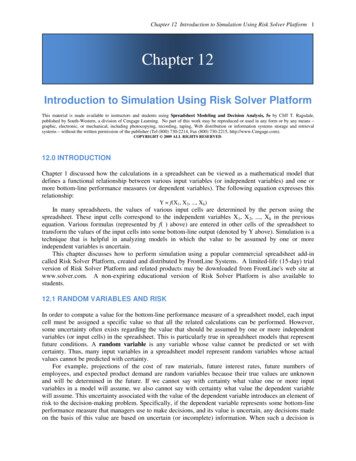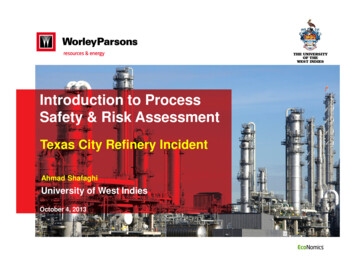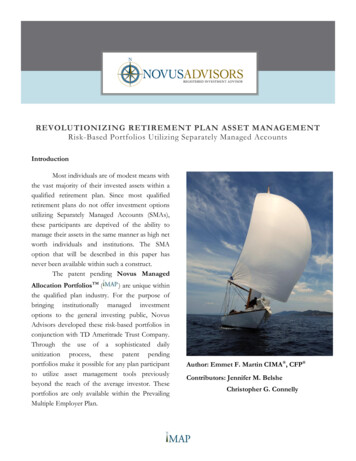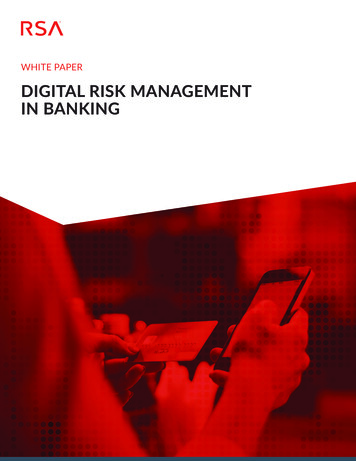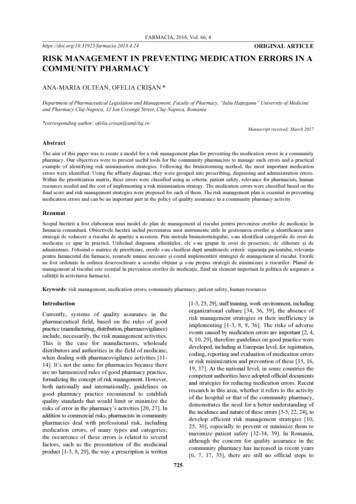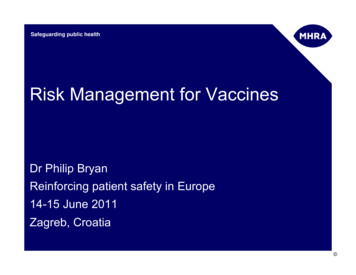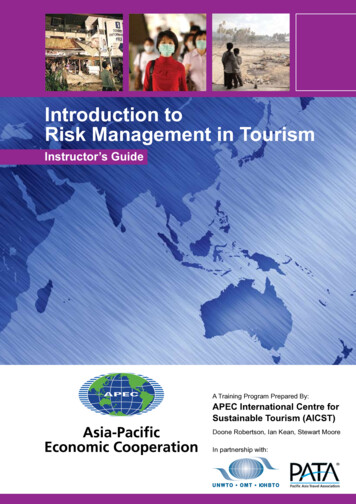
Transcription
Introduction toRisk Management in TourismInstructor’s GuideA Training Program Prepared By:APEC International Centre forSustainable Tourism (AICST)Doone Robertson, Ian Kean, Stewart MooreIn partnership with:
This training program is an initiative of the APEC International Centre for Sustainable Tourism (AICST). It isbased on an earlier report entitled “Tourism Risk Management in the Asia Pacific Region – An AuthoritativeGuide to Managing Crises and Disasters” published in 2004.The major partner in the project is the United Nations World Tourism Organization (UNWTO). The Pacific AsiaTravel Association (PATA) is also a project partner.Production TeamThe research, editorial and production team was led by Sustainable Tourism Services.The principal writer was Doone Robertson, an experienced emergency management consultant and theDirector of Studies at the Australian School of Emergency Management.Other writers and researchers who assisted with this report are: Ian Kean, Executive Director of AICST, Australia Stewart Moore, Managing Director of Sustainable Tourism Services, Australia Yetta Gurtner, PhD Research Student from the Centre for Disaster Studies at James Cook University, inAustralia Cara Holcombe, Project Manager at Sustainable Tourism Services, Australia Dr Jeff Wilks, Centre for Tourism and Risk Management at University of Queensland, AustraliaUse of the report and its contentsThe report is intended to be freely used by governments and the tourism industry throughout the Asia-Pacificregion and beyond. It must not be used for commercial gain. The report and its contents must be used aspresented and cannot be amended in any way without the written permission of AICST, which holds aworldwide license for the report and its contents from the Australian Government.AcknowledgementsAustralian Government - This project was principally funded by the Australian Department of Industry, Tourism& Resources as an AusAID APEC Support Program project. All intellectual property developed by this projectbelongs to the Australian Government.Cover photography acknowledgements:Jim Holmes courtesy of Oxfam, ABC Library Sales and Journal Sentinel OnlinePublished byAsia-Pacific Economic Cooperation (APEC)APEC Secretariat35 Heng Mui Keng Terrace, Singapore 119616Telephone Number: (65) 6775 6012Facsimile Number: (65) 6775 6013Website: www.apec.orgAPEC #206-TO-03.1ISBN981-05-6732-4General DisclaimerThis report mentions the activities and experiences of a number of organizations and individuals. Theseactivities and names are given for record and as examples, but do not entail automatic endorsement by AICSTor its project partners. While all care has been taken to check and validate material presented in this report,independent professional and/or legal advice should be sought before any action or decision is taken on thebasis of material contained in this report. The contents of this report do not reflect the views of the AustralianGovernment and should not be relied upon as reflecting Australian Government views. The AustralianGovernment shall not be liable, in any way, for any loss arising from use or reliance upon material in thispublication by another person.Introduction to Risk Management in Tourism - Instructor’s Guide1
Instructor’s GuideIntroduction to Risk Management in TourismIntroduction to the Instructor’s GuideThis workshop training package provides the fundamentals necessary for a basicunderstanding of the risk management process in tourism.Whilst a half-day workshop cannot provide detailed information, this activity doesprovide an overview and general underpinning knowledge of risk managementconsistent with the roles and responsibilities of tourism operators and appropriate tothe limited time available for the conduct of the training.Importantly, the workshop establishes a framework within which learning cancontinue. It’s essential for participants to understand that the workshop is only thebeginning of their learning process, not an end point. The workshop activity and theresource material provided will provide participants with a base to build upon.Significantly, the workshop provides an invaluable opportunity for the establishmentof risk management information sharing networks which can be supported andendorsed by tourism organisations and associations within a destination. On-goinglearning and information exchange should be a key outcome of these workshops.The key points to emphasise throughout the workshop are: the tourism industry is vital to the economic viability of all countries; risk management is an on-going process; it’s important to share information and experiences of crises amongst tourismdestinations and operators so that we can all continue to learn from each other forthe benefit of the tourism industry as a whole; and there are official agencies in each country with responsibilities for disasterpreparedness, response and recovery management. These agencies can belocated at local, State/Provincial, and National government levels. The aim of aTourism Risk Management Strategy is not to duplicate or complicate theresponsibilities and activities of these agencies but, rather, to show what tourismorganisations can do to supplement and compliment the activities of the disastermanagement agencies to add additional elements of safety for visitors and staff.2Introduction to Risk Management in Tourism - Instructor’s Guide
ProgramIntroduction to Risk Management in TourismHalf day – Four Hour ProgramSessionDurationWelcome/Introduction10 minutesCrisis and Disaster20 minutesOverview of Risk Management Process15 minutesEstablish Context15 minutesIdentify Risk15 minutesMorning/Afternoon Tea20 minutesSyndicate Discussion Exercise 130 minutesAnalyse Risk20 minutesEvaluate Risk15 minutesTreat Risk15 minutesMonitor and Review15 minutesSyndicate Discussion Exercise 230 minutesCourse Summary & Closure10 minutes(Timing allows 10 minutes for two short breaks between sessions.)Introduction to Risk Management in Tourism - Instructor’s Guide3
Session 1 – Welcome and IntroductionAimThis session is designed to provide an overview of the content of the workshop, andto introduce the instructional team and participants.Learning Outcomes:The session will enable participants to: outline the workshop structure and content; and identify course team members and participants.Timing:10 minutesNote : the symbol indicates a PowerPoint slide.Method:1. Welcome participants, explain housekeeping issues including coffee break andlocation of facilities; introduce course instructor/s, and summarise the scopeand content of the workshop.2. Make clear that this workshop will provide an overview of risk management intourism, that the workshop is a starting point in the learning process, not anend point. Explain that in addition to the manual on risk management, they arealso being provided with a participant’s workbook which contains information,activities and questions relating to the risk management process. Theworkbooks are a resource, designed to assist participants to extend theirknowledge and understanding of risk management in tourism.3. Next, invite participants to introduce themselves, giving a very brief summary oftheir role in tourism. The following may assist in this process: My name is . I work in tourism as a (position) .at (location) Our last major crisis or disaster was .4Introduction to Risk Management in Tourism - Instructor’s Guide
4. Encourage participants to interact with the instructional team and each other toenhance their learning and to assist in establishing networks.Explain to participants that this activity is only one element of their learningprocess – each crisis or community disaster or exercise will further developtheir knowledge and skills in risk management and it is important to sharethose with other tourism personnel and destinations.Key Points: This is the start of the learning process. There is a need to establish and maintain risk management networks acrosstourism destinations and the industry. It is important to share knowledge, lessons and experiences.Introduction to Risk Management in Tourism - Instructor’s Guide5
Session 2 – Introduction to Crisis and DisasterAimThis session is designed to clarify the terms crisis and disaster.Learning Outcomes:The session will enable participants to: explain the critical role of tourism in APEC communities; define crisis in a tourism context; define disasters affecting communities; and compare and contrast the two situations.Timing:20 minutesMethod:1. Begin by explaining that tourism is one of the major generators of social andeconomic growth in the world and one of the leading drivers of internationaltrade. It is important that the value of tourism is clearly understood bygovernments and communities. Tourism generates income, creates andsustains jobs, encourages foreign investment and facilitates trade for alleconomies.Risk management is an invaluable tool for the visitor industry and thecommunities it supports as it provides the means by which risk can beidentified and treated, preventing or minimising the effects of crises anddisasters upon this vital industry.2. Explain that we shall be defining crisis as: ‘Any situation that has the potential to affect long-term confidence in anorganization or a product, or which may interfere with its ability to continueoperating normally.’Crisis is the term which applies to both tourism destinations and individualbusinesses where the confidence in tourism is affected and where the ability tocontinue normal tourism operations is impaired.6Introduction to Risk Management in Tourism - Instructor’s Guide
Crises for tourism destinations and operators may arise from internal(organisational) sources or from external events (community events such asthe impact or threat of a disaster).Ask the group: what are some examples of crises which might affect visitordestinations or businesses? Accept any reasonable answer, but ensure thatthey focus upon business or organisational crises, not community disasters.3. Next, the term disaster. Explain that while there are many definitions of disasterin current use, all share common threads - there is disruption to thecommunity which is of such a magnitude that responding organisations,infrastructure and resources are overwhelmed, and there is an inability toreturn to normal without external assistance. Define disaster as: ‘a serious disruption to community life which threatens orcauses death or injury in that community and/or damage to property which isbeyond the day-to-day capacity of the prescribed statutory authorities andwhich requires special mobilisation and organisation of resources other thanthose normally available to those authorities’.4. Explain that disasters are different in kind and in scope from day-to-dayemergency incidents. Disasters are not simply bigger events; they have asignificant impact upon people and infrastructure and thus upon tourismfacilities, operations and visitors. They also produce long-term problems ofrestoration and rehabilitation and so may affect the return to normal of tourismactivities for a considerable period of time. In addition, most or all of thebusinesses reliant on tourism will also be impacted to a significant extent.Ask participants: what are some of the ways in which tourism will be affectedby a community disaster?5. Explain that disaster management requires an integrated system: an activepartnership between governments and authorities, organisations, agencies andthe community. Where possible, the tourism industry should participate in the integrateddisaster management system at all levels – local community level for tourismoperators and destinations; national and international level for tourismorganisations and associations.Ask participants: Does your tourism industry have links with communitydisaster management agencies? Does tourism attend disaster managementplanning meetings?Introduction to Risk Management in Tourism - Instructor’s Guide7
If the answer is no, that’s an important task for them to address – to ensure thattourism establishes and maintains liaison with disaster management agencies,and participates on multi-agency disaster planning committees.Key Points: A crisis affects tourism in a destination or business. A disaster affects a whole community. Tourism will inevitably be affected by a community disaster. Tourism destinations and organisations should be involved in disastermanagement committees at local, regional, national and international level.Link:Explain that now that we’ve looked at the broad picture of community disasters andthe role of tourism destinations and businesses in supporting disaster managementsystems, we’re going to narrow the focus and concentrate on the process of riskmanagement for destinations and businesses.8Introduction to Risk Management in Tourism - Instructor’s Guide
Session 3 – Overview of the Risk Management ProcessAimThis session is designed to outline the stages of the risk management process.Learning Outcomes:The session will enable participants to: identify the stages of the risk management process; describe the purpose of risk management; identify communication and consultation as integral to the process; discuss stakeholders relevant to tourism; and establish the relevance of risk management to the tourism industry.Timing:15 minutesMethod:1.Explain that risk management process was designed to provide a genericframework for organisations in the identification, analysis, assessment, treatmentand monitoring of risk. It has been adapted by the disaster management community and is widely usedby them throughout Asia and the Pacific as a community-based, multi-agencyprocess. Different names are used. For example - in the Pacific, it’s known asCHARM (Comprehensive Hazard and Risk Management); at the Asian DisasterPreparedness Centre in Bangkok it’s called Community-Based Disaster RiskManagement.2.The important point here for the tourism people is that they understand there is a single organisational process which is the process that is used for applicationby the tourism industry to tourism destinations and tourism businesses and amulti-agency community process.So, when they work with disastermanagement agencies in their communities they will contribute to thecommunity-based process.Introduction to Risk Management in Tourism - Instructor’s Guide9
But, they should also undertake an organisational risk management processto identify, analyse, assess, treat and monitor risk to their tourism destination,businesses and operations.3.Describe the basic elements of the risk management process. Emphasise that communication and consultation are fundamental to riskmanagement, and must be undertaken at each step in the process. A two-wayprocess of internal and external communication and consultation must beestablished and maintained between decision-makers and stakeholders so thatdifferent views and areas of expertise are considered. Ask participants: which stakeholders are relevant to the tourism industry andoperators? Who do you need to communicate with and consult within your ownorganisation and in your community?Key Points: Risk management provides a generic framework to identify, analyse,assess, treat and monitor risk. Risk management processes apply to single business or organisation and toa community. Disaster risk management is a multi-agency, community-based process. Tourism operators, destinations and organisations should be involved indisaster management committees at local, regional, national andinternational level. Tourism destinations should also undertake organisational risk managementfor their destinations. Communication and consultation are the basis of the process.10Introduction to Risk Management in Tourism - Instructor’s Guide
Session 4 – Establish the ContextAimThis session is designed to establish the basic parameters or framework within whichrisk management activities take place.Learning Outcomes:The session will enable participants to: identify the internal and external environment for the risk management process;and suggest risk criteria for a tourism industry or operator.Timing:15 minutesMethod:1.Explain that this step in the risk management process establishes the policies,systems, procedures and intra-organisational and inter-organisationalrelationships which are relevant to the tourism destinations or operators,including: Perceptions, values and interests of visitors. Political and legal environment in which tourism operates; Social influences; Competitors; Financial/economic factors; and Key business drivers.Briefly discuss how each might affect tourism.Ask participants: what internal factors are relevant to a tourism-based riskmanagement process for a destination or a business? Organisational culture; Capabilities of the tourism industry and operators;Introduction to Risk Management in Tourism - Instructor’s Guide11
Economic constraints; Goals and objectives of the tourism industry/operator; Level of community support for tourism; Organisational strengths, weaknesses; opportunities, and threats. 2.Next, explain that part of the context is to develop risk criteria. These aresimple, basic statements of what is unacceptable and will not be tolerated by thetourism industry or operator. Examples of risk criteria for the tourism industrymight include: Any preventable crisis which results in negative media reporting of thetourism industry is unacceptable. Any preventable crisis which makes visitors reluctant to visit a destination orvisitor facility is unacceptable.Ask participants to suggest other examples – one for a destination and one for asingle tourism operator.Explain that developing these risk criteria will help them to decide which risksneed to be treated.Key Points: The context establishes the basic parameters within which risk managementactivities take place. It establishes statements of what is unacceptable to visitor operators ordestinations.12Introduction to Risk Management in Tourism - Instructor’s Guide
Session 5 – Identify RiskAimThis session is designed to outline the process of identifying risk.Learning Outcomes:The session will enable participants to: identify the risk relevant to a tourism destination or operator; examine factors affecting vulnerability and resilience; and establish that risk doesn’t remain static.Timing:15 minutesMethod:1.Explain that it’s necessary to identify the sources of risk (hazards) to the tourismdestination or operator, including, importantly, those which pose a threat to thesafety and security of visitors and employees.Ask participants: where might you find useful information about sources of risk toyour organisation?Various means should be used to identify all sources of risk, including: Brainstorming ideas with personnel Checking historical records Consulting experts Using scenario analysis (‘what if this happened here?’)Where possible, they should also identify the cause of the risk.2.The next step is to identify the elements which would be affected: visitors,employees, structures, services, facilities, reputation, etc, if the sources of risk(hazards) were to impact upon the tourism destination or business. Introduction to Risk Management in Tourism - Instructor’s Guide13
In other words, they should identify each of the elements which might beaffected by each of the sources of risk which might impact upon theorganisation.Using ‘poor safety record’ as an example of risk, ask participants which of thefollowing elements - visitors/employees, reputation, facilities, economic viability would be affected. Then compare and contrast those results with the impact of an epidemic uponthe same elements of the organisation.Explain that this process helps to prioritise sources of risk – those which aff
of risk management information sharing networks which can be supported and endorsed by tourism organisations and associations within a destination. On-going learning and information exchange should be a key outcome of these workshops.



